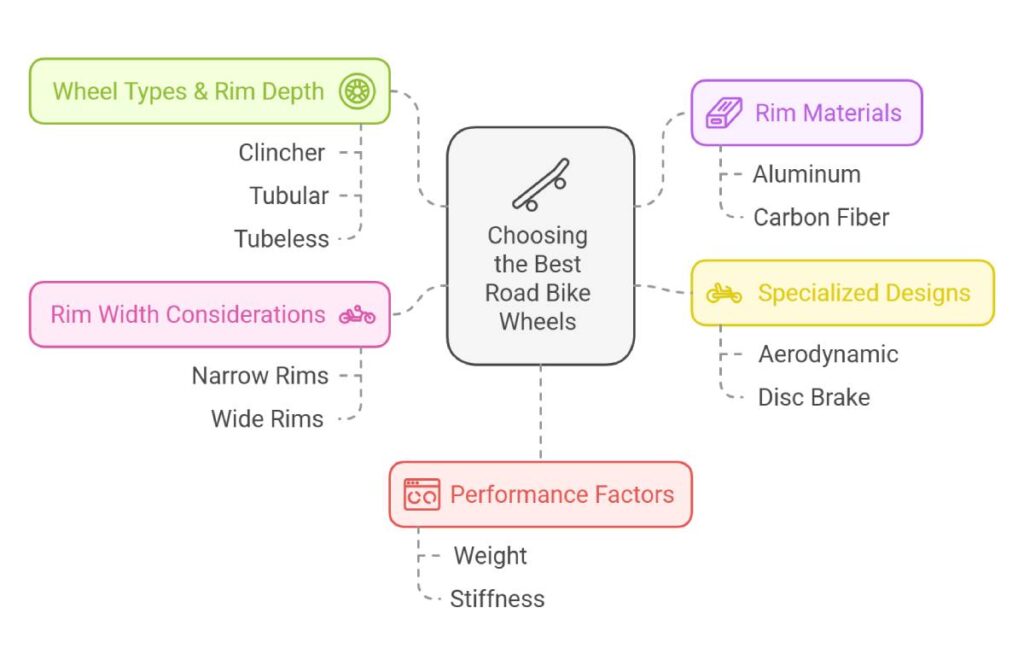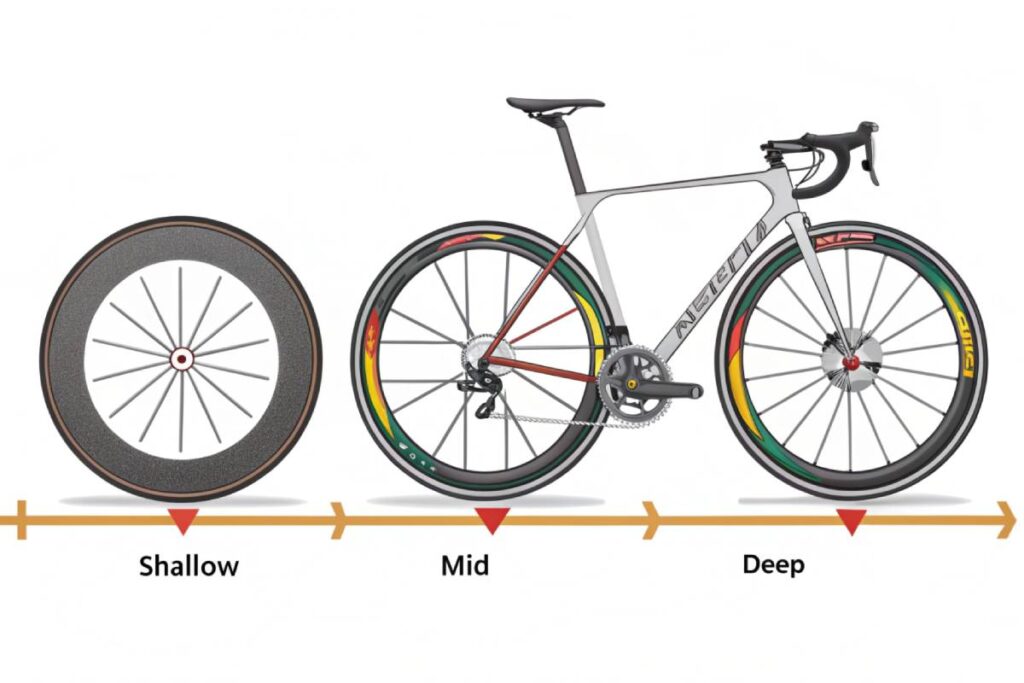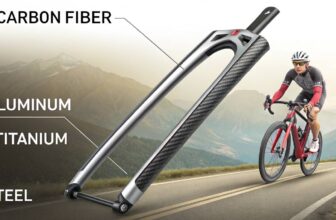Embarking on a cycling journey? The wheels you choose are more than just spokes and rims—they’re the heartbeat of your ride.
Imagine slicing through the wind with effortless speed or conquering steep hills with unwavering stability. Whether you’re a weekend warrior, a seasoned racer, or a daily commuter, selecting the perfect road bike wheels can transform your cycling experience.
Dive into our comprehensive guide to discover how rim material, depth, and design can elevate your performance, ensuring every pedal stroke brings you closer to your cycling goals. Let’s roll into the world of wheel warriors and find the best wheels for your journey!
Understanding Bicycle Wheels
Picking just the right wheels for your road bike can seriously up your cycling game. Let’s get into why choosing the right wheels matters and the impact that rim material and depth have on your ride.
Importance of the Right Wheels
Wheels aren’t just round things on your bike. They are the MVPs, affecting how fast you zoom in and how stable and comfy your ride feels. Whether you’re new to biking, a weekend warrior, or racing like a pro, knowing which wheels to pick makes a difference. The right ones can make your ride smoother and your bike handling like a dream, especially when the road gets tricky.
| Wheel Type | Best For | Key Characteristics |
|---|---|---|
| Shallow Section Wheels | Climbing and Stability | Light, quick acceleration, and comfy |
| Mid Section Wheels | Aerodynamic Efficiency in Rolling Terrain | Deeper profile, combining speed and control |
| Deep Section Wheels | Maximum Aerodynamic Efficiency | Heavier, keep momentum, smarter aerodynamics |
Check out the skinny on road bike wheel depth for more deets.
Impact of Rim Material and Depth
The material and depth of your rims make a huge difference in how your bike performs. Knowing how they work helps riders choose wisely.
- Rim Material: The wheels are typically made from sweet carbon fiber or trusty aluminum.
- Carbon Fiber Wheels: These babies are light and stand up for awesome aerodynamics. They’re gold for cutting drag, perfect for racing and beating the clock. But yeah, they’re a bit spendy and need some TLC. Discover more on the battle of carbon vs aluminum road bike.
- Aluminum Wheels: Tough and easy on the wallet, aluminum wheels are solid for everyday use and practice sessions. They give you a nice mix of zip and value.
- Rim Depth:
- Shallow Section Wheels (0-30mm): Best pals with hill climbs and speedy sprints. These guys are light, take off like a rocket, and stay steady in windy weather.
- Mid Section Aerodynamic Wheels (30-50mm): Great in rolling land, these wheels blend aerodynamics and flexibility. They’re a go-to for bikers, taking on different terrains like champs.
- Deep Section Wheels (50mm+): Heroes on flat land and in races, these wheels are heavy but keep moving like a breeze. They bring epic aero perks but need a steady hand in side winds.
| Rim Depth | Best For | Characteristics |
|---|---|---|
| Shallow (0-30mm) | Climbing, frequent speed changes | Light, rocket-fast takeoff, stable in wind |
| Mid (30-50mm) | Rolling terrains, all-around use | Chunky, high speed-keeping, aero goodies, tricky in the wind |
| Deep (50mm+) | Flat terrain, time trials, racing | Chunky, high speed-keeping, aero goodies, tricky in wind |
Getting to grips with these details helps you pick the best road bike wheels that match your riding vibe. For more pro-tips to fine-tune your ride, check out articles on road bike geometry, road bike tire pressure, and road bike brakes.

Choosing the Right Wheel Profile
Picking the right wheel profile for your road bike is a game-changer when it comes to boosting both performance and comfort. The wheels you choose can fundamentally alter how your bike deals with various terrains and weather. So, let’s roll through the options and find the perfect set for your cycling adventures.

Shallow Section Wheels
Shallow section wheels come with low-profile rims, usually less than 25mm deep. These babies are the best friends of climbers and endurance riders, thanks to their feather-light build and impressive handling on hilly roads. They’ve got a knack for soaking up road vibrations, making your ride smoother than freshly churned butter.
Who Are They For?
- Riders tackling steep ascents (over 6% gradients)
- Those in for the long haul on all-day rides
- Commuters and trainers logging miles on the daily
Sweet Benefits:
- Super light and easily maneuverable
- Unmatched comfort for your bum
- Excellent control when side winds come a-calling
| Feature | Shallow Section Wheels |
|---|---|
| Rim Depth | < 25mm |
| Best Use | Climbing, Training |
| Weight | Light |
| Crosswind Stability | High |
Mid Section Wheels
Mid section wheels fall in the 35mm to 45mm rim depth range, finding that sweet spot between weight, aero gains, and flexibility. They’re like the jack-of-all-trades wheel, handling rolling terrains like a pro, offering wind-cheating benefits without making you wrestle the bars in a gust.
Who Are They For?
- Cyclists cruising rolling hills
- Competitors in road races and triathlons
- Riders who want it all — speed, control, versatility
Sweet Benefits:
- Slices through the air with aerodynamic finesse
- Handles diverse terrains with ease
- Well-balanced combo of weight and speed
| Feature | Mid Section Wheels |
|---|---|
| Rim Depth | 35mm – 45mm |
| Best Use | Road Racing, Triathlons |
| Weight | Moderate |
| Crosswind Stability | Moderate |
Deep Section Wheels
Deep section wheels, with rims 50mm deep or more, are the go-to for those wanting to slash through the air at top speed. They’re the wheels you’d take out for time trials or flat-out races, giving you a crazy aero edge. Just remember, their size might catch the wind more, but that’s the price of going fast on flat tracks.
Who Are They For?
- Time trialists chasing PBs
- Racers on flat, open roads
- Speed demons are all about the pace
Sweet Benefits:
- Top-notch aerodynamic whizz
- Turbo boosts you on straight stretches
| Feature | Deep Section Wheels |
|---|---|
| Rim Depth | ≥ 50mm |
| Best Use | Time Trials, Racing |
| Weight | Heavier |
| Crosswind Stability | Lower |
When it comes down to it, the right wheel profile boils down to what you need and how you ride. If you’re looking to step up your cycling game, check out our piece on road cycling techniques. For more info on rim width and materials, our guides on road bike wheel depth and carbon vs aluminum road bikes have you covered.
Grasping what sets these wheel types apart will set you on the path to more fulfilling rides. Whether scaling hills, zipping through the wind, or seeking an all-rounder, there’s a wheel out there just for you.
Specialized Wheel Designs
It’s not rocket science, folks: wheels matter when you’re riding a bike. These bad boys can change the whole vibe of your ride, boosting speed, handling, and comfort. Let’s nosey around two wheel types—gravel wheels and performance-bustin’ disc wheels.
Gravel Wheels
If you’re the adventurous type who likes your roads bumpy and unpredictable, gravel wheels are your jam. Think of them as the SUV of bicycle wheels—built to muscle through all that mixed-up terrain you’ll encounter off-road and on.
Gravel wheels have rims that can handle a football game, typically wider than 20mm. Why so wide? To support those chunky tires ranging from 32mm to 50mm. This design stands strong against tire deformities and gifts you with extra grip and a smoother ride.
| Feature | Specification |
|---|---|
| Internal Rim Width | 20mm or greater |
| Tire Width Range | 32mm to 50mm |
| Brake Type | Disc Brakes |
| Key Benefits | Durability and Stability |
These wheels usually come with disc brakes—the kind that won’t leave you hanging regardless of the weather. They’re like your trusty sidekick when things get dicey.
Disc Wheels for Performance
Let’s chat about disc wheels, the superhero sidekick for cyclists chasing the clock—like racers and triathletes. They aren’t just wheels; they’re aerodynamic wonders slicing through the air, minimizing drag, and pumping up your speed. Believe it or not, these wheels grew out of a safety hack to protect kids’ feet from spokes. Later on, triathletes clued in on their speed secrets.
Disc wheels are either solid or nearly so, cutting through the air like a knife, meaning you need less oomph to keep the speedometer happy. You’ll spot these beauties in time trials and triathlons, where every second is worth its weight in gold.
| Feature | Specification |
|---|---|
| Rim Type | Solid/Nearly Solid |
| Aerodynamic Benefit | High |
| Common Use | Time Trials, Triathlons |
| Key Benefits | Reduced Drag, More Speed |
Heads up, though—on a windy day, these wheels can act more like a sail than you might want, especially if you’re not quite the seasoned pro yet. Check out some smooth cycling moves at road cycling techniques to stay in control.
Gravel and disc wheels aren’t just for show—they each have their place on specific paths and rides. Picking the right wheels means knowing what floats your boat—or in this case, your bike. For more nuggets of wisdom on wheels and keeping them in tip-top shape, scope out our reads on road bike wheel depth and road bike maintenance.
Considerations for Rim Width
Rim width plays a big part in how comfy, steady, and zippy your road bike runs. Knowing the right size and why wider rims rock can help you pick the right ones with confidence.
Optimal Width Range
Road bike wheels have come a long way, baby. These days, most road and triathlon rims are rocking between 19mm and 28mm. The size around and in between the rims can make your bike ride like a dream or like a nightmare.
| Rim Width Type | Common Range (mm) |
|---|---|
| Inside Rim Width | 19 – 21 |
| Outside Rim Width | 26 – 28 or 30 – 32 |
Matching up your tire with what the maker suggests is not just a tip—it’s a must. This pairing acts like a safety net, making sure you’re rolling smoothly and fast for way longer. Wanna geek out more on how rim width makes your bike fly? Peek at our article on road bike wheel depth.
Wider Rims for Comfort
More and more bikers are embracing chunkier rims, and it’s no surprise why. What’s not to love about extra comfort? These fat boys let your tire puff out a little bigger, which means you can roll with less air pressure. Less air pressure? It’s like rolling on clouds, soaking up the bumps and keeping you fresh on those cross-country cruises.
These wider rims also turn your bike into a super-steady beast, especially on gnarly surfaces. For those speed freaks and distance warriors burning miles, this added stability is a total game changer. Plus, they’ve got your back when battling side winds on downhill dashes or when gusts are giving you grief.
For more about pimping out your ride with the right gear and skills, swing by our reads on road bike tires and road cycling techniques.
Checking out the perfect width and why wide rims rule helps you find the best wheels for your ride vibe.
Carbon vs. Alloy Wheels
Deciding on carbon fiber or aluminum alloy wheels is a big deal for road cyclists. Let’s spell out the benefits of each so you can pick what suits you best.
Advantages of Carbon Fiber Wheels
Carbon fiber wheels are like the rock stars of cycling, packing a punch with their top-notch performance traits:
- Aerodynamics: Built for speed, these sleek rims cut through the air like butter, which means less drag and better efficiency in races or long rides.
- Weight: Lighter than a feather—or almost—carbon wheels make your bike quicker off the mark and easier to handle (ICAN Cycling).
- Vibration Absorption: With the leaf spring effect, carbon wheels soak up bumps and jolts for a smoother ride.
- Stiffness: Their solid build is great for turning your muscle power into road speed, especially when racing.
| Attribute | Carbon Fiber Wheels |
|---|---|
| Aerodynamics | Superior |
| Weight | Super Lightweight |
| Vibration Absorption | Top-notch |
| Stiffness | Solid |
Pair these speed demons with the right bike geometry and gearing for a performance boost.
Advantages of Aluminum Wheels
Aluminum alloy wheels score points for being practical and tough:
- Cost: Generally kinder on your wallet, alloy wheels open the door for more cyclists to ride in style.
- Durability: Tough as nails, these wheels laugh in the face of potholes and minor crashes.
- Braking Performance: Known for stopping on a dime, especially in rain, without needing any fancy brake pads.
- Maintenance: Easier and cheaper to keep them rolling, plus simpler fixes than their carbon pals.
| Attribute | Aluminum Wheels |
|---|---|
| Cost | Budget-Friendly |
| Durability | Very Tough |
| Braking Performance | Dependable |
| Maintenance | Low Hassle and Cost |
Picking between these wheels depends on your cycling style and bank balance. Aluminum excels for daily riders and weekend enthusiasts, while carbon is a winner for those chasing records and endurance.
When choosing the right wheels, look at gear like the perfect tire pressure and the best road bike tires to complete your cycling ride.
Performance Factors of Wheels
Picking out the perfect road bike wheels can be like choosing the right shoes for a dance-off – it could make or break your ride’s flow. So, let’s look at what really counts when you’re on the hunt. Two biggies are how slick the wheels slide through the air and just how heavy they are. Get this stuff right, and you’re in for some smooth sailing.
Aerodynamic Efficiency
When it comes to letting you slice through the wind without much of a fuss, aerodynamic efficiency is your best friend. Those meaty deep-section wheels, often made from carbon, are like the sports cars of the wheel world. The rule of thumb? The deeper the wheel, the less air it’s got to fight, which means you can zoom past onlookers faster than those shallower options.
It’s pretty much a known fact that deep wheels are champs at cutting through the wind. But if you look closely at wheels of different depths, you’ll see the difference is more about style than performance when you compare today’s models. Opt for wheels with some serious depth to give you the upper hand in time trials and flat-out races.
| Wheel Depth | Aerodynamic Drag Reduction |
|---|---|
| Shallow (30mm) | Little Drag |
| Mid Section (50mm) | Some Drag |
| Deep Section (>60mm) | Woosh! |
Craving more details on wheel depth? Check out our in-depth guide on road bike wheel depth.
Weight and Inertia Effects
Now, let’s yap about weight and inertia, the unsung heroes of a wheel’s mojo. A featherweight wheel is a dream during climbs and sprints because it doesn’t take as much oomph to get moving. Racers swear by carbon wheels for good reason: they come light as a feather but rock hard.
Shed some wheel weight, and you’re flying up any hill. This trifecta of stiffness, care-free compliance, and pared-down weight means you have a rip-roaring ride.
| Wheel Type | Average Weight (g) |
|---|---|
| Carbon Fiber (Deep Section) | 1,300 – 1,600 |
| Aluminum (Shallow Section) | 1,600 – 2,000 |
When you’re gearing up your bike, think about both those wind-slicing properties and if you’re hauling rocks or feathers. Keen to learn about how different materials mix things up? Hop on over to our write-up on carbon vs. aluminum road bike wheels. Nail these choices, and you’ll pedal through every ride like it’s a walk in the park, whatever the path.
Factors Affecting Riding Experience
Getting the right feel on a road bike isn’t just about hopping on and pedaling. Several things come into play, like stiffness, how forgiving the ride is, wheel weight, and how wind sneaks up on you. Wrapping your head around these details will point you to the best road bike wheels for your rides.
Stiffness, Compliance, and Weight
Think of stiffness as how much a wheel pushes back when you’re cranking the pedals. More stiffness means your power doesn’t just vanish into thin air; it hits the road hard. Compliance, though, is like the wheel’s soft side—it shakes off those annoying road vibrations for a ride that’s less about gritting your teeth and more about enjoying the view.
And then there’s weight. It’s a biggie. Lighter wheels gear up faster, perfect for sprinting off the line or stop-and-go city rides. But on those climbs that don’t seem to end, you’ll feel every ounce.
| Factor | Impact |
|---|---|
| Stiffness | Power straight to pavement, smoother steering |
| Compliance | Cushioned ride, fewer rattles |
| Weight | Quicker off the line, must-have on climbs |
Impact of Wind Conditions
Got wind? It’s a game-changer when biking. Deep rims slice through the air like nobody’s business—speed comes easy, and less sweat is needed. But hit a crosswind and things get wobbly.
Flatter rims, on the other hand, keep things steady when breezes kick up, which lighter riders or those dealing with gusty days might appreciate. Rim shape and how much you weigh also spice up how your ride reacts to weather shifts.
| Rim Depth | Wind Impact |
|---|---|
| Deep Section | Zips through air, tricky in crosswinds |
| Shallow Section | Solid in windy weather, less speed bonus |
Picking the right wheels is about mixing these elements to fit your style of riding and the usual weather you face. Whether you’re racing for the podium, cycling just for fun, or conquering weekend trails, knowing this stuff can seriously step up your riding experience. Looking for more ways to pimp your setup? Dive into our tips on road bike geometry and road bike maintenance.
Rolling Resistance and Tire Technology
How your bike rolls can make or break your race, turning those epic rides into sheer misery. No one wants to pedal harder while going slower, right? Let’s dive into the tire tech world and see how it helps you zoom like a road warrior on two wheels.
Tubeless vs. Tubular Tires
Two heavy hitters in the tire arena: tubeless and tubular. Each one offers its own perks, kind of like picking between a Swiss army knife and a samurai sword.
Tubeless Tires
Who needs tubes these days? Tubeless tires are the talk of the town among cycling enthusiasts. Ditching the inner tube lets these bad boys run at lower pressures, gracing you with a better grip and easier spinning across all terrains.
Tubeless tire perks:
- Smoother rollin’
- Fewer “oh crap, a flat!” moments
- A ride that feels like a hug
| Feature | Tubeless Tires |
|---|---|
| Inner Tube Needed | Nope |
| Flat Resistance | Through the roof |
| Comfort Level | Like cruising on clouds |
| Rolling Drag | Down to a minimum |
Tubular Tires
Enter the tubular tires, the trusted companion of bike racers through thick and thin. These are tires-on-a-string, sewn around a tube and glued to ensure they stick like a band-aid on a knee.
Tubular tire perks:
- Featherweight
- Can handle the pressure—literally
- Tough cookie with a finesse touch
| Feature | Tubular Tires |
|---|---|
| Inner Tube Needed | Yes, it’s sewn in |
| Flat Resistance | Middle of the road |
| Comfort Level | Quite good |
| Rolling Drag | Depends on the mood of the road |
For the full skinny on various tires, check out our detailed road bike tire types guide.
Energy Loss in Tires
When your tires hug the road a little too tight, you’re losing energy big time. Let’s chat about why your tires are gobbling up your precious pedal power.
Factors Affecting Rolling Resistance
- Tire Pressure: Think of it as Goldilocks’ porridge—not too hard and not too soft. Cranking up or dialing down the pressure can massively impact how your ride feels. Want a smoother cruise? Get your road bike tire pressure just right.
- Compound and Casing: Calling on the science folks here! Tire material affects how much oomph you need to keep going. Softer rubbers just can’t keep energy in check when the road gets cranky.
- Tire and Rim Width: When it comes to rims and tires, it’s about width, baby. Wider tires, wider rims, less rolling resistance, and a comfier ride—it’s a win-win!
| Influencing Factor | Does It Make Rolling Easier? |
|---|---|
| Tire Pressure | Low leads to more drag |
| Rubber Mix | Softer = more energy lost |
| Rim & Tire Width | Wider gives a smoother ride |
Grasping these tidbits might save your energy for another lap or tougher hill climbs. If you’re hungry for more, check out our guides on road cycling techniques and road bike maintenance to push the limits of your gear and have a blast while doing it.
Conclusion
Choosing the right road bike wheels is pivotal to enhancing your cycling performance and overall riding pleasure. From understanding the significance of rim depth and material to selecting specialized designs like gravel and disc wheels, each decision shapes your journey on two wheels.
Shallow wheels offer agility and comfort for climbs, while deep sections maximize aerodynamic efficiency for racing. Carbon fiber rims provide lightweight speed, whereas aluminum wheels deliver durability and value for everyday rides.
Additionally, optimizing rim width and tire technology can further refine your ride, ensuring minimal rolling resistance and maximum control. By grasping these elements, you empower yourself to make informed choices that align with your cycling goals, whether you’re aiming for speed, endurance, or versatility.
Equip your bike with the perfect wheels, and watch as every ride becomes smoother, faster, and more enjoyable. Ready to elevate your cycling game? Explore our additional guides on road bike geometry, tire pressure, and maintenance to keep your wheels—and your passion—rolling strong.
FAQs
What factors should I consider when choosing road bike wheels?
When selecting road bike wheels, consider rim depth, material (carbon fiber vs. aluminum), width, intended use (climbing, racing, all-around), aerodynamic efficiency, weight, and compatibility with your bike’s frame and brakes.
Are carbon fiber wheels worth the investment?
Yes, carbon fiber wheels offer superior aerodynamics, reduced weight, and better vibration absorption, making them ideal for racing and high-performance cycling. However, they are pricier and require more careful maintenance compared to aluminum wheels.
How does rim depth affect my ride?
Rim depth influences aerodynamic performance and stability. Shallow rims (<30mm) are great for climbing and stability in crosswinds, mid-depth rims (30-50mm) balance aerodynamics and versatility, while deep rims (>50mm) maximize speed on flat terrains but can be challenging in strong crosswinds.
Should I choose tubeless or tubular tires for my road bike?
Tubeless tires offer smoother rolling, fewer flats, and better grip, making them suitable for varied terrains. Tubular tires are lighter and provide reliable performance in racing conditions but require more maintenance. Your choice depends on your riding style and priorities.
What is the optimal rim width for road bike wheels?
Most road bike rims range between 19mm and 28mm in width. Wider rims (20mm+) enhance comfort and stability by allowing wider tires, which can improve grip and reduce rolling resistance. Ensure your rim width matches your tire size for optimal performance.
Final Thoughts
Selecting the ideal road bike wheels is a blend of understanding your personal riding style, the terrains you frequent, and the performance attributes you seek. From the lightweight agility of carbon fiber to the rugged reliability of aluminum, each material offers unique benefits tailored to different cycling needs.
Additionally, the rim depth and width play crucial roles in aerodynamics and comfort, directly influencing your speed and stability. Specialized wheels like gravel and disc wheels further expand your cycling possibilities, allowing you to tackle varied terrains with confidence.
Don’t overlook the importance of tire technology and rolling resistance, as these factors can significantly impact your energy efficiency and overall ride quality. By taking the time to evaluate these elements and invest in the right wheels, you’re not just upgrading a component—you’re enhancing your entire cycling experience.
Embrace the journey of finding the perfect wheels, and watch as every ride becomes smoother, faster, and more enjoyable. Happy cycling!
Key Tips
- Assess Your Riding Style: Determine whether you prioritize speed, comfort, or versatility to choose the appropriate wheel type.
- Match Rim and Tire Width: Ensure your rim width complements your tire size for optimal performance and safety.
- Consider Weather Conditions: Select wheel profiles that handle your typical riding conditions, such as deep rims for calm weather and shallow rims for windy areas.
- Balance Weight and Aerodynamics: Find a balance that suits your cycling goals, whether it’s climbing efficiency or flat terrain speed.
- Maintain Your Wheels: Regularly check for wear and ensure proper maintenance to extend the lifespan and performance of your wheels.
Recommended Biking Products and Accessories
- Mavic Cosmic Pro Carbon Wheels Lightweight carbon fiber rims are ideal for racing and high-performance cycling.
- Shimano Dura-Ace Aluminum Wheelset Durable and reliable aluminum wheels perfect for everyday riding and training.
- WTB Byway Gravel Wheels Versatile gravel wheels designed for mixed terrains and adventurous trails.
- Zipp 303 Firecrest Disc Wheels High-aerodynamic disc wheels tailored for time trials and triathlons.
- Bontrager Paradigm Tubeless Tires Enhanced grip and reduced rolling resistance for a smoother ride.
- Park Tool Wheel Truing Stand Essential tool for maintaining wheel alignment and performance.
- Knog Blinder Road Bike Fenders Protective fenders keep you clean and dry in various weather conditions.
- Garmin Edge 1030 Bike Computer Advanced tracking and performance metrics to optimize your cycling experience.
- Spank Aero WSP Shifters Precision shifting components for seamless gear changes during rides.
- Specialized Turbo Vado SL Electric Bike Wheels Electric-assisted wheels for enhanced performance and extended ride ranges.
By implementing these enhancements and additions, your article will not only captivate readers from the start but also provide comprehensive, SEO-optimized content that keeps them engaged until the very end.




